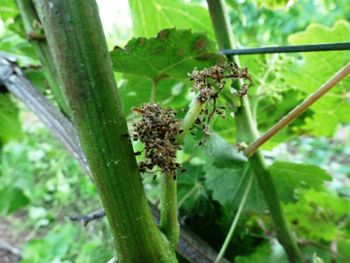Rainy, Set, Grow?

By Jessica Cortell
Around the time of bloom, growers anxiously monitor the weather and the events taking place from the start of bloom through fruit set. In the vine, competition for carbohydrates and nutrients rages between growing shoot tips and the developing flowers. The outcome at the end of bloom will determine the yield potential for the vintage.
There is also the question of what influence the previous season has because this is when cluster initiation begins. At least as far back as 2007, there have been alternating patterns of high and low yields in the Willamette Valley.
Several factors contribute to yield, including the number of vines per acre, clusters per vine and cluster weight, which is determined by the number of berries per cluster and berry weight. Percent fruit set determines the number of berries in a cluster. The percent fruit set is the number of fertilized berries per number of flowers multiplied by 100. In Pinot Noir, fruitset is typically around 30 percent. Consequently, cluster size can be influenced by the initial number of flowers and the events that determine how many of those flowers develop into berries.
At the time of bloom, the carbohydrates and nitrogen stored in the trunk and roots are at a minimum and actively growing shoots and flowers are competing for these nutrients. At the same time, weather events such as cool rainy periods can further disrupt bloom and fruit set. Several disorders called inflorescence necrosis (IN), “hens and chicks” (millerandage) and shatter (coulure ) can occur during bloom or fruit set.
Inflorescence necrosis is a disorder in which the entire cluster of flowers turns brown and dies. It is thought to be associated with carbohydrate starvation and a buildup of ammonium, which can become toxic at high levels. The disorder is most common when cool, cloudy conditions prevail during bloom, in high vigor vines and in dense, shady canopies. This year, a number of growers are reporting significant IN in high-vigor vines, particularly own-rooted vines and also vineyard sites that bloomed earlier during rainy, cool weather. Vineyard sites in the northern Willamette Valley suffered worse IN, possibly due to starting bloom earlier than vineyards to the south.
Shatter is a term used to describe higher-than-normal aborted berries. This can occur in cold rainy weather and also if very high unseasonal temperatures occur. This year, right around the start of bloom, the weather turned cool and rainy. Photosynthesis slowed and competition for carbohydrates increased. Developing flowers could not compete with growing shoot tips when nutrients became limited and this led to the abortion of berries resulting in poor fruit set.
This year, many vineyards experienced significant shatter. Joel Myers of Vinetenders Vineyard Management says he is seeing significant shatter and clusters with only 50 to 80 berries per cluster. This statement agrees with my observations in the Eola Hills. I also observed a low number of flower buds per cluster. Some clusters had only around 100 to 150 flowers to start with, so if 30-percent fruitset is anticipated … you do the math. That equals a small cluster. We won’t be seeing the big bomber clusters of last year. Literally, this year, two clusters per shoot will be equivalent to one cluster per shoot last year, if we are lucky.
“Hens and chick,” or millerandage, is another fruit set disorder in which the cluster has both full size and small berries caused by uneven fertilization. Some of the small berries with one or no seeds will abort. This can affect yield, as the small berries generally do not size up, skewing yield estimates.
Count twice, cut once or not at all could be the guideline for yield estimates and fruit thinning this year. In many vineyards, yield adjustment will not be necessary. A cluster with 50 to 80 berries will typically weigh around 60 to 100 grams (.13 to .22 pounds), depending on berry size. This is very different from last year, when many vineyards harvested half-pound Pinot Noir clusters, suggesting we could easily see lower yields across Oregon by 20 percent or possibly more.
The advantages of a small crop are that less labor and expense will be needed to do fruit thinning, clusters will be smaller, more open and less prone to disease, improved fruit quality and the small crop will help in absorbing any available fruit on the market.
A possible disadvantage is that some growers might end up in a situation where the cost of vineyard management is not offset by the price garnered for the small crop.








